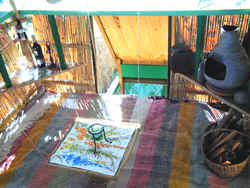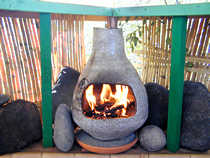A Path to Ecotectural Awareness
I began to see the hooch as an appropriate candidate for a low impact, eco-friendly structure. As a pre-fabricated structure, it could be built off-site, further reducing the site impact. Pre-fabrication also reduces waste of time and material. Subsequent hooch projects (a total of five) placed the hooch amidst idyllic settings, along rivers and in old growth forests, demonstrating yet another asset—it would be a great place to commune with nature. Birds fly through it. Animals are oblivious to the occupants residing high above. We observed great white herons gracefully gliding over the river, and deer passed peacefully beneath our perch. The renowned biologist E.O. Wilson first proposed the concept of "biophilia," in his book by that name. Biophilia hypothesizes that man, a product of nature, requires a constant interaction with nature to maintain a healthy mental state. Wilson's hypothesis has since been verified in numerous studies (see Environmental Design and Construction magazine at edcmag.com), and should be seen as a fundamental tenet of human oriented architecture. A space with plants and vistas will be a more pleasant place to be. Such a place is the hooch.
|
Some people just know how to live.
(Note the Bamboo Wine Opener). (Interior) |
While I had no intention of designing a prefabricated, treeless treehouse, the hooch became just that, the ultimate destination of my path to an ecologic design. As it was originally intended for the tropics, the design criteria did not include an allowance for creating a separate comfort zone. It is open, and intimately responsive to the local micro-climate. I am now working out an alternative energy solution to providing a comfort zone even in the coldest months of the (Oregon Coastal) winter. We now use down comforters, and a ceramic chiminea, a Mexican ceramic fireplace, for radiant heat. Although comfort has certainly been achieved, a quest for an enclosed, warm environment is an ongoing project.
On the darker side of this adventure in design, I have confronted the unmovable and all-powerful building establishment. The unconventional nature of the hooch is contrary to and totally out of step with conventional building techniques. An attempt to achieve credibility through an exhaustive structural analysis has met with several endemic problems, though the structural integrity of the basic design was conceded.
First, to even begin to adhere to architectural conventions, the hooch's base must be securely tied to the ground to resist earthquakes. If it is not tied down, the structure will shake free of its location because the base will move with the earth while the inertia of the main structure above will tend to keep it in place. This rule assumes that the structure is not otherwise supported. The hooch, though, has cables to surrounding trees, and is also tied to the ground. The hooch will move in concert with the ground, thus minimizing its tendency to remain in one place while the base moves about. The relatively low mass of the hooch further augments this strategy, as little force is required to change its position.
Second, the attachments to trees do not conform to the building codes. The strength of the trees, their root holding power, is not quantifiable. With no established basis for assigning the holding power of these anchors, the structural integrity of the hooch cannot be defined. Designing for the worst-case scenario, the ultimate wind load, is the basis for this structural assessment—the possibility that the wind load on the hooch might actually exert enough of a pull on a tree so that it becomes uprooted. As unlikely as this might seem, it is hopelessly unquantifiable, and therefore precludes a verifiable structural assessment.
|
Enough warmth for a moderate climate. |
In true outlaw fashion, however, I dance on loopholes, exceptions, and the vagaries of interpretations of the Uniform Building Code (UBC). I have kept all my hooches less than 120 square feet in floor area, an arbitrary limit under which the UBC does not apply. I also rely on the ephemeral nature of the hooch as a temporary structure. With no true foundation, it is indeed temporary, and, therefore, exempt. The hooch is far from a permanent abode, and is not meant to be one. Instead, it is intended as an outbuilding, an accessory to a permanent home. Though permanent occupancy is not legal, the hooch can be used in a variety of ways, including as a temporary "bedroom."
I am sure that the hooch can be made "legal", however. With a solid center foundation, and foundations for all surrounding cable connections, the hooch's structural integrity can be documented. In addition, thorough, specific site analysis would insure proper compensation for the specific geologic conditions. Personally, I am not enthusiastic about these draconian measures, as they would compromise or even negate the beauty of the hooch, specifically its environmental connectedness and otherwise unaltered site adaptability. Wiser now, I am humbled, but not dissuaded. The hooch is too much fun to be discarded in the face of uninspired regulation.
A part of, rather than apart from, that is the mantra. The overwhelming evidence of the folly of unsustainable growth, materialism, and consumption is prompting a shift in values and an awareness of our impact on the environment, and the realization that we too are part of the grand scheme of things. The movement is not currently dominant, as the inertia of consumptive capitalism is huge. Yet, the switch is necessary, and inevitable. It need not be disruptive. The longer the change is delayed, however, the greater the risk of disruption, not only economic, but also environmental and climactic.
My path and the ultimate product of my desire to achieve a more earth-friendly existence, in hindsight, may be relegated to the garbage dump of history. The hooch is not the eco-shelter for all humanity, though it certainly works for me, and for all those who have encountered it. I have built five hooches to date: two in Puerto Rico, and three in Oregon. There are others as well, as the design continues to inspire like-minded builders. With each new site and situation, more possibilities reveal themselves. It is an ongoing project, and one for which I retain an undaunted enthusiasm. It is my path with a clear and moral intention. In my eternal optimism, I would hope that it might be recycled, and that perhaps it might find a niche. After all, that would be the sustainable path.
(Jo Scheer is a designer, builder, and writer in Ashland, Oregon. His bamboo designs and hooch have been featured in several books, including World Treehouses: the House that Jack built, by David Pearson; and Bamboo Style, by Gale Beth Goldberg. His website, http://www.tropical-treehouse.com, features his home in Puerto Rico as a vacation rental, and also features the hooch, with pictures, plans, and construction services.)

